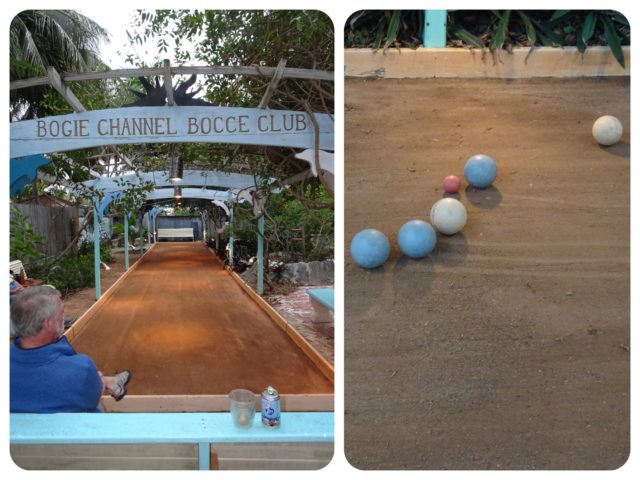Saturday was our last day in the Keys with Tim and Amanda and what a full day it was. We kicked it off with a trip to the Big Pine Flea Market, held on Saturdays and Sundays. There were booths with everything and anything your heart might desire – cheap souvenir stuff, higher end merchandise, antiques and collectibles, hardware, fishing equipment, plants, produce, clothing……… and so on.

I didn’t expect to purchase anything, but I found something to add to a collection of mine.


The mini-donuts provided us with enough sustenance for continuing on to Marathon to visit the “The Turtle Hospital”. The admission price for a tour was more than expected, but the cause is very worthy. The Hospital opened in 1986 with four goals: “1) rehab injured sea turtles and return them to their natural habitat, 2) educate the public through outreach programs and visit local schools, 3) conduct and assist with research aiding to sea turtles (in conjunction with state universities), and 4) work toward environmental legislation making the beaches and water safe and clean for sea turtles.”

The tour began with a short presentation by our guide to provide a little turtle background.

There are 7 species of sea turtles throughout the entire world. Five of the seven are found in Florida:
- Leatherback (9-12 feet long and weighs up to 2,000 lbs.)
- Green (3-5 feet long, weighs 200-500 lbs.)
- Loggerhead (2-4 feet long, weighs 200-350 lbs.)
- Hawksbill (2-3 feet long, weighs 100-150 lbs.)
- Kemp’s Ridley (2-2½ feet long, weighs 75-100 lbs.)

What brings a turtle to the hospital? A turtle emergency. The website has directions on who to call (Florida Fish and Wildlife Conservation Commission, Coast Guard, or a 24-hour hot line) and how to identify a turtle in distress. In a literal sense, humans bring the turtles to the hospital. When someone does find and report an injured turtle, they get to name the turtle.
Outdoors there are 23 individual tanks, ranging in size from 150-800 gallons. The largest tank is the 100,000 gallon salt water pool.
The first tank held green sea turtles recovering from fibropapillomatosis (FP), an aggressive virus that causes benign tumors to grow mostly around the turtles’ flippers, neck, eyes, and sometimes internally. Without the ability to move or see, a turtle’s survival is seriously threatened. Surgery is the only option.

A boat’s propeller or a hull can cause significant damage to a turtle’s shell, as hard as it is. Sometimes when a turtle is hit by a boat, the damage can prevent the turtle from submerging, possibly due to air that is trapped under the shell, or other physiological damage. A turtle must be able to submerge in order to survive in the wild. The hospital named this condition “Bubble Butt Syndrome,” after the turtle who first arrived with this problem in 1989.
Lead weights are attached to the shell so that the turtle can submerge. This is not a permanent solution for life in the wild because those weights will eventually fall off. Any turtles that arrive at the hospital with “bubble butt” safely spend the remainder of their life there.

Turtles are not picky eaters and will chomp down almost anything. Unfortunately there are many synthetic things floating in the oceans that are not digestible. This leads to an intestinal blockage, called an impaction. In the wild, without assistance, the turtle cannot eliminate the impaction and will starve to death. At the hospital, turtles are treated with Metamucil, fiber and vegetable oil. This is why humans must be more careful of trash disposal!
Turtles can also ingest fishing hooks that can cause damage to their digestive tract and frequently become trapped in fishing line and buoy lines. (Fishing line takes 600 years to biodegrade.) Worst case scenario, the turtle may drown or loose a flipper due to loss of circulation.
Another tank held a group of 15 small Kemp’s Ridley turtles that had been rescued near Cape Cod, MA on January 2nd and brought to the hospital. They should not have been that far north in cold waters and became ill, “cold-stunned.” The website has updated their status – they were released on Feb 9th in North Florida. Success!

The permanent residents live in the last, very large, saltwater tank.


Our visit to the Turtle Hospital was definitely worth the time and money. They are doing good things there with their focus on “rescue, rehab and release.”
Enough for one day? Nah………… We had a party to attend that evening! Amanda’s father, Bill, hosts “bocce night” every week in his back yard. Bill has a cool little place on Big Pine, living life the way a native “conch” should, although he is really a “freshwater conch”, spending his summers in Vermont.
We finally saw Key Deer, especially in Bill’s neighborhood. Key deer are only found in the lower Florida Keys and 75% of them live on Big Pine and No Name Keys. In the 1950’s the Key deer population had dropped to only a few dozen animals. The formation of the National Key Deer Refuge and the designation of Key deer as an endangered species in 1967 led to a striking recovery of the species, which now numbers almost a thousand. Evidently they are very friendly and readily approach people looking for tidbits and snacks, which is why this sign warns drivers to be careful.
Back to bocce. Neither Al or I had ever played bocce before. We had a lot to learn. Rolling balls down a sand court doesn’t sound complicated, but there are a lot of rules. Fortunately, everyone else plays regularly and were patient teachers.


Wow, What a day! From the flea market to the bocce party, it was a great last day in the Keys. Thank you, Tim and Amanda, and Bill, too. 🙂 Tomorrow we would be heading northward back to the west coast of Florida.














Leave a Reply